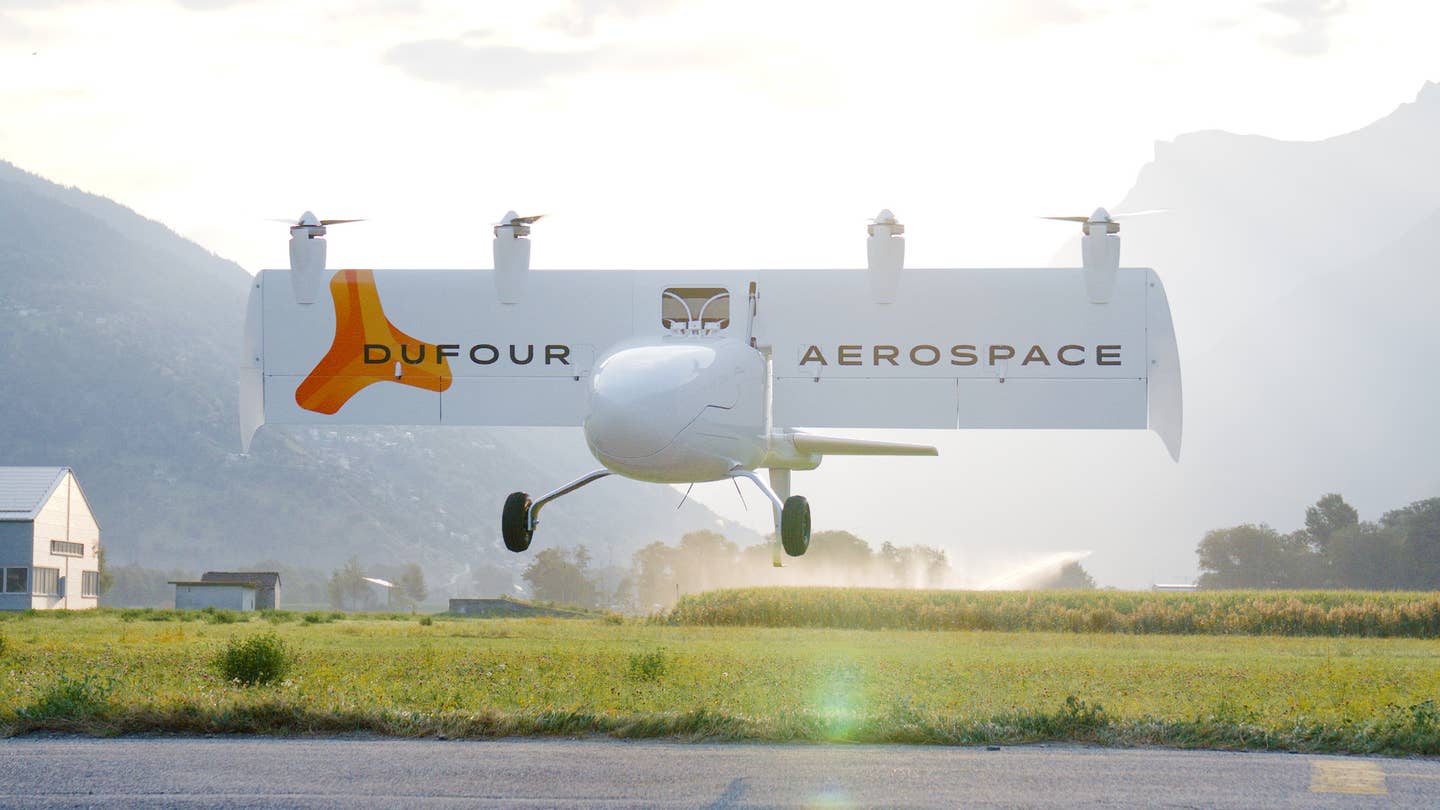Dufour Releases Final Design for Aero2 Drone
Tilt-wing eVTOL manufacturer is targeting prototype flight testing by 2024 and serial production by 2025.

Dufour’s Aero2 eVTOL prototype features tilt wings that can be oriented horizontally or vertically. [Courtesy: Dufour Aerospace]
A tilt-wing electric vertical takeoff and landing (eVTOL) aircraft, billed as “the Swiss Army knife of drones,” just obtained its final design and specifications.
The aircraft in question, Swiss eVTOL manufacturer Dufour Aerospace’s Aero2, has been in development for years and is now entering its final prototype phase, the firm announced Thursday.
It’s a huge milestone for Dufour. Designed to enable flight testing and certification before the autonomous Aero2 enters serial production in 2025, the fourth and final prototype, X2.3, is just about ready to be built. Slated to begin testing in early 2024, X2.3 will bring Dufour closer to European Union Aviation and Safety Agency (EASA) design approval.
The announcement follows Dufour’s historic deal with Spright—a subsidiary of helicopter services firm Air Methods—for the purchase of up to 140 Aero2 aircraft, one of the largest civilian drone purchases to date.
More recently, the company secured a Series B funding raise led by Vista Global, one of the world’s leading private aviation groups. It also earned a $2.8 million grant from Innosuisse, the innovation agency of the Swiss Confederation, the most it was eligible to receive.
Aero2’s unique, tilt-wing design gives it the vertical lift capabilities of a helicopter with the cruise speed of a winged plane. The key differences between X2.3 and Dufour’s previous prototype—which has flown successfully at the firm’s airfield in Dübendorf, Switzerland—are an improved maximum takeoff weight (around 459 pounds) and the addition of hybrid-electric propulsion through a frame contract with Suter Industries.
And while the latest prototype is projected to have a slightly slower cruise speed (81 knots versus 92 knots in earlier iterations), Dufour will give it more ground clearance and a larger fuselage and wingspan. Other changes include a new front-loading mechanism, the replacement of a conventional tail with a more stable H-tail configuration, and swapping ducted fans for a rear propeller.
“Aero2 is able to transport 88 [pounds] over a distance of 215 nm. The structure and systems have to be safe and aerodynamically efficient, and delivering this is not an easy task,” said Simon Bendrey, Dufour’s head of design. “I’m especially proud of the hard work of our teams to lock in a design that will meet or exceed our customers’ stringent requirements.”
Aero2’s specifications—which also include redundant motors and control surfaces as well as a flight time of three hours in standard configuration—make it a good fit for multiple operations, hence the “Swiss Army knife” moniker.
Dufour envisions it being used to deliver critical cargo, such as blood and vaccines, conduct remote sensing and data gathering (including beyond the visual line of sight), and enable public safety operations from search and rescue to wildfire prevention to border monitoring.
Now, the company is acquiring the materials needed to build the X.23 design, which will align with EASA’s Specific Assurance and Integrity Level IV (SAIL IV) standards. The agency has yet to fully define the requirements and means of compliance for that approval, which would enable operations over populated areas. But as soon as it does, Dufour plans to apply for it.
“Dufour Aerospace is working hard to develop the Aero2, and we have full confidence in their ability to deliver their innovative product,” said Joseph Resnik, president and CEO of Spright. “We’ve worked closely with the team at Dufour for more than one year now and are pleased with the progress being made. In close contact with our existing and prospective customers, we see a huge potential for this aircraft for numerous applications.”
In addition to the Spright deal, Dufour agreed to a long-term contract with Blueberry Aviation that will see the commercial aircraft and helicopter specialist purchase 100 Aero2 drones. The agreement also calls for Blueberry to acquire 100 Aero3 aircraft—a larger, piloted model that Dufour expects will become its flagship product.
Aero3 will maintain the tilt-wing and hybrid-electric propulsion components of Aero2 and is expected to handle a similar range of operations. The difference is it will hold up to eight passengers and fly farther, faster, and more efficiently than its predecessor, capable of carrying a useful load of 1,650 pounds.
Dufour is working to certify Aero3 by late 2025, about a year after Aero2 is expected to be approved. Worth noting, though, is the firm initially anticipated serial production of Aero2 to begin this year—that date has now been pushed back.

Subscribe to Our Newsletter
Get the latest FLYING stories delivered directly to your inbox






